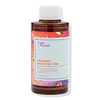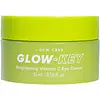What's inside
What's inside
 Key Ingredients
Key Ingredients

 Benefits
Benefits

 Concerns
Concerns

No concerns
 Ingredients Side-by-side
Ingredients Side-by-side

Water
Skin ConditioningGlycerin
HumectantNiacinamide
Smoothing1,2-Hexanediol
Skin ConditioningPropanediol
SolventArbutin
AntioxidantBetaine
HumectantGlycyrrhiza Glabra Root Extract
Bleaching3-O-Ethyl Ascorbic Acid
Skin ConditioningEthylhexylglycerin
Skin ConditioningCarbomer
Emulsion StabilisingTromethamine
BufferingTrisodium Ethylenediamine Disuccinate
Theobroma Cacao Seed Extract
AntioxidantSodium Hyaluronate
HumectantDextrin
AbsorbentTocopherol
AntioxidantWater
Skin ConditioningGlycerin
HumectantDiisostearyl Malate
EmollientHydrogenated Poly(C6-14 Olefin)
Emollient1,2-Hexanediol
Skin ConditioningEthylhexyl Palmitate
EmollientLimnanthes Alba Seed Oil
Skin ConditioningNiacinamide
SmoothingPentaerythrityl Tetraethylhexanoate
EmollientPolymethylsilsesquioxane
Myristyl Myristate
EmollientPEG-150 Distearate
EmulsifyingPolyglyceryl-3 Methylglucose Distearate
EmulsifyingCetearyl Alcohol
EmollientCI 77891
Cosmetic ColorantHydrogenated Olive Oil Lauryl Esters
Emulsion StabilisingPentylene Glycol
Skin ConditioningSqualane
EmollientEuphrasia Officinalis Extract
AntimicrobialHydrolyzed Hyaluronic Acid
HumectantAscorbic Acid
AntioxidantPalmitoyl Tripeptide-5
Skin ConditioningCamellia Sinensis Leaf Extract
AntimicrobialLuffa Cylindrica Fruit Extract
Skin ConditioningPsidium Guajava Fruit Extract
AstringentPsidium Guajava Leaf Extract
AstringentTocopherol
AntioxidantCyanocobalamin
Skin ConditioningCoffea Arabica Seed Extract
MaskingHydrogenated Lecithin
EmulsifyingGlyceryl Stearate
EmollientMica
Cosmetic ColorantHydroxyethyl Acrylate/Sodium Acryloyldimethyl Taurate Copolymer
Emulsion StabilisingCopernicia Cerifera Wax
Theobroma Grandiflorum Seed Butter
Skin ConditioningCaprylic/Capric Triglyceride
MaskingCaprylyl Glycol
EmollientBehenic Acid
CleansingSilica
AbrasiveSynthetic Fluorphlogopite
Stearic Acid
CleansingBehenyl Alcohol
EmollientStearyl Alcohol
EmollientHydrogenated Olive Oil Unsaponifiables
EmollientXanthan Gum
EmulsifyingParfum
MaskingEthylhexylglycerin
Skin ConditioningAdenosine
Skin ConditioningPolyglyceryl-10 Stearate
Skin ConditioningMyristic Acid
CleansingDisodium EDTA
Phenoxyethanol
PreservativeMelia Azadirachta Flower Extract
Skin ConditioningMelia Azadirachta Leaf Extract
Skin ConditioningCurcuma Longa Root Extract
MaskingOcimum Sanctum Leaf Extract
Skin ConditioningButylene Glycol
HumectantCorallina Officinalis Extract
Skin ConditioningAllium Sativum Bulb Extract
Skin ConditioningWater, Glycerin, Diisostearyl Malate, Hydrogenated Poly(C6-14 Olefin), 1,2-Hexanediol, Ethylhexyl Palmitate, Limnanthes Alba Seed Oil, Niacinamide, Pentaerythrityl Tetraethylhexanoate, Polymethylsilsesquioxane, Myristyl Myristate, PEG-150 Distearate, Polyglyceryl-3 Methylglucose Distearate, Cetearyl Alcohol, CI 77891, Hydrogenated Olive Oil Lauryl Esters, Pentylene Glycol, Squalane, Euphrasia Officinalis Extract, Hydrolyzed Hyaluronic Acid, Ascorbic Acid, Palmitoyl Tripeptide-5, Camellia Sinensis Leaf Extract, Luffa Cylindrica Fruit Extract, Psidium Guajava Fruit Extract, Psidium Guajava Leaf Extract, Tocopherol, Cyanocobalamin, Coffea Arabica Seed Extract, Hydrogenated Lecithin, Glyceryl Stearate, Mica, Hydroxyethyl Acrylate/Sodium Acryloyldimethyl Taurate Copolymer, Copernicia Cerifera Wax, Theobroma Grandiflorum Seed Butter, Caprylic/Capric Triglyceride, Caprylyl Glycol, Behenic Acid, Silica, Synthetic Fluorphlogopite, Stearic Acid, Behenyl Alcohol, Stearyl Alcohol, Hydrogenated Olive Oil Unsaponifiables, Xanthan Gum, Parfum, Ethylhexylglycerin, Adenosine, Polyglyceryl-10 Stearate, Myristic Acid, Disodium EDTA, Phenoxyethanol, Melia Azadirachta Flower Extract, Melia Azadirachta Leaf Extract, Curcuma Longa Root Extract, Ocimum Sanctum Leaf Extract, Butylene Glycol, Corallina Officinalis Extract, Allium Sativum Bulb Extract
 Reviews
Reviews

Ingredients Explained
These ingredients are found in both products.
Ingredients higher up in an ingredient list are typically present in a larger amount.
1,2-Hexanediol is a synthetic liquid and another multi-functional powerhouse.
It is a:
- Humectant, drawing moisture into the skin
- Emollient, helping to soften skin
- Solvent, dispersing and stabilizing formulas
- Preservative booster, enhancing the antimicrobial activity of other preservatives
Ethylhexylglycerin (we can't pronounce this either) is commonly used as a preservative and skin softener. It is derived from glyceryl.
You might see Ethylhexylglycerin often paired with other preservatives such as phenoxyethanol. Ethylhexylglycerin has been found to increase the effectiveness of these other preservatives.
Glycerin is already naturally found in your skin. It helps moisturize and protect your skin.
A study from 2016 found glycerin to be more effective as a humectant than AHAs and hyaluronic acid.
As a humectant, it helps the skin stay hydrated by pulling moisture to your skin. The low molecular weight of glycerin allows it to pull moisture into the deeper layers of your skin.
Hydrated skin improves your skin barrier; Your skin barrier helps protect against irritants and bacteria.
Glycerin has also been found to have antimicrobial and antiviral properties. Due to these properties, glycerin is often used in wound and burn treatments.
In cosmetics, glycerin is usually derived from plants such as soybean or palm. However, it can also be sourced from animals, such as tallow or animal fat.
This ingredient is organic, colorless, odorless, and non-toxic.
Glycerin is the name for this ingredient in American English. British English uses Glycerol/Glycerine.
Learn more about GlycerinNiacinamide is a multitasking form of vitamin B3 that strengthens the skin barrier, reduces pores and dark spots, regulates oil, and improves signs of aging.
And the best part? It's gentle and well-tolerated by most skin types, including sensitive and reactive skin.
You might have heard of "niacin flush", or the reddening of skin that causes itchiness. Niacinamide has not been found to cause this.
In very rare cases, some individuals may not be able to tolerate niacinamide at all or experience an allergic reaction to it.
If you are experiencing flaking, irritation, and dryness with this ingredient, be sure to double check all your products as this ingredient can be found in all categories of skincare.
When incorporating niacinamide into your routine, look out for concentration amounts. Typically, 5% niacinamide provides benefits such as fading dark spots. However, if you have sensitive skin, it is better to begin with a smaller concentration.
When you apply niacinamide to your skin, your body converts it into nicotinamide adenine dinucleotide (NAD). NAD is an essential coenzyme that is already found in your cells as "fuel" and powers countless biological processes.
In your skin, NAD helps repair cell damage, produce new healthy cells, support collagen production, strengthen the skin barrier, and fight environmental stressors (like UV and pollution).
Our natural NAD levels start to decline with age, leading to slower skin repair, visible aging, and a weaker skin barrier. By providing your skin niacinamide, you're recharging your skin's NAD levels. This leads to stronger, healthier, and younger looking skin.
Another name for vitamin B3 is nicotinamide. This vitamin is water-soluble and our bodies don't store it. We obtain Vitamin B3 from either food or skincare. Meat, fish, wheat, yeast, and leafy greens contain vitamin B3.
The type of niacinamide used in skincare is synthetically created.
Learn more about NiacinamideTocopherol (also known as Vitamin E) is a common antioxidant used to help protect the skin from free-radicals and strengthen the skin barrier. It's also fat soluble - this means our skin is great at absorbing it.
Vitamin E also helps keep your natural skin lipids healthy. Your lipid skin barrier naturally consists of lipids, ceramides, and fatty acids. Vitamin E offers extra protection for your skin’s lipid barrier, keeping your skin healthy and nourished.
Another benefit is a bit of UV protection. Vitamin E helps reduce the damage caused by UVB rays. (It should not replace your sunscreen). Combining it with Vitamin C can decrease sunburned cells and hyperpigmentation after UV exposure.
You might have noticed Vitamin E + C often paired together. This is because it is great at stabilizing Vitamin C. Using the two together helps increase the effectiveness of both ingredients.
There are often claims that Vitamin E can reduce/prevent scarring, but these claims haven't been confirmed by scientific research.
Learn more about TocopherolWater. It's the most common cosmetic ingredient of all. You'll usually see it at the top of ingredient lists, meaning that it makes up the largest part of the product.
So why is it so popular? Water most often acts as a solvent - this means that it helps dissolve other ingredients into the formulation.
You'll also recognize water as that liquid we all need to stay alive. If you see this, drink a glass of water. Stay hydrated!
Learn more about Water